- Home
- James McBride
Kill 'Em and Leave
Kill 'Em and Leave Read online
Copyright © 2016 by James McBride
All rights reserved.
Published in the United States by Spiegel & Grau, an imprint of Random House, a division of Penguin Random House LLC, New York.
SPIEGEL & GRAU and the HOUSE colophon are registered trademarks of Penguin Random House LLC.
LIBRARY OF CONGRESS CATALOGING-IN-PUBLICATION DATA
Names: McBride, James.
Title: Kill ’em and leave: searching for James Brown and the American soul / James McBride.
Other titles: Kill them and leave
Description: New York: Spiegel & Grau, 2016
Identifiers: LCCN 2015026358 | ISBN 9780812993509 | ISBN 9780679645627 (ebook)
Subjects: LCSH: Brown, James, 19332006. | Soul musicians—United States—Biography. | LCGFT: Biographies.
Classification: LCC ML420.B818 M33 2016 | DDC782.421644092—dc23 LC record available at http://lccn.loc.gov/2015026358
eBook ISBN 9780679645627
randomhousebooks.com
spiegelandgrau.com
Book design by Caroline Cunningham, adapted for ebook
Title page and part title background image from FreeImages.com/Billy Alexander
Cover design: Alex Merto
v4.1
ep
Contents
Cover
Title Page
Copyright
Epigraph
Foreword
Part I: Countin’ Off
Chapter 1: Mystery House
Chapter 2: Cussin’ and Fussin’
Chapter 3: American Jive
Part II: Hit It!
Chapter 4: The Vapors
Chapter 5: Six Gaines
Chapter 6: Leaving the Land
Chapter 7: Bro
Chapter 8: To Live Standing
Chapter 9: The Last Flame
Chapter 10: The Rev
Chapter 11: The Money Man
Chapter 12: The Earth Beneath His Feet
Chapter 13: More Money
Chapter 14: The Hundred-Dollar Man
Chapter 15: The Rag That Nobody Reads
Chapter 16: Sis
Part III: Quit It!
Chapter 17: Say Goodbye to the King
Chapter 18: The Dream
Epilogue: Sister Lee
Dedication
Acknowledgments
By James McBride
About the Author
If you’re not about the truth, you’re not qualified to play any kind of music.
—PROFESSOR WENDELL LOGAN (November 24, 1940–June 15, 2010), founder of the Jazz Department, Oberlin Conservatory of Music
The statue sits smack in the middle of downtown Augusta, Georgia, face high, because the old man never wanted to be standing above anybody else. He wanted to be down with the people. And as you stand before it on this deserted stretch of cheap stores and old theaters on a hot August afternoon, you say to yourself, “This is what they don’t teach you in journalism school”: to walk through the carcass of a ruined, destroyed life—this broken life and the one behind it, and the one behind that—to navigate the maze of savage lawyers who lined up to feed at the carcass; to listen to the stories of the broke musicians who traveled the world in glory only to come home with a pocket full of nothing; to make sense of the so-called music experts who helped themselves to a guy’s guts and history trying to make a dollar change pockets. Everybody’s got a hustle in this world. Meanwhile the guy who made the show, he’s deader than yesterday’s beer, his legacy scattered everywhere but where he wanted it.
James Brown, the Godfather of Soul, America’s greatest soul singer, left most of his wealth, conservatively estimated at $100 million, to educate poor children in South Carolina and Georgia. Ten years after his death on December 25, 2006, not a dime of it had reached a single kid. Untold millions have been frittered away by lawyers and politicians who have been loosed on one another by various factions of his destroyed family.
It’s a sad end to an extraordinary yet tragic life, though you figure with thousands of poor kids in South Carolina and Georgia needing a good education, somebody would have the integrity to figure the whole thing out. But that’s a long shot these days because, in part, that would mean we’ve figured out James Brown. And that’s impossible. Because to figure him out, we’d have to figure ourselves out. And that’s like giving an aspirin to a two-headed baby.
It’s an odd thing. They’re big on him here in Augusta, his adopted hometown. They named an arena after him and a street, held a James Brown Day, all of that tribute jazz. But the truth is, other than this weird statue, there’s not a wisp of James Brown in this place. There’s no feeling of him here. He’s a vapor now, just another tragic black tale, his story bought and sold and bought again, just like the slaves that were once sold at the Haunted Pillar just two blocks from where his statue stands. Brown’s saga is an industrial-strength story, a big-box store of a life filled with cheap goods for any writing hack looking for the equivalent of the mandatory five-minute gospel moment you see in just about every Broadway show these days. Lousy story, great music. And everybody’s an expert: a documentary here, a book there, a major motion picture, all produced by folks who “knew” and “loved” him, as if that were possible. The fact is, it really doesn’t matter whether they knew him or not, or loved him or hated his guts and hoped somebody would tie him to a pickup truck and drag his body across the quit line. The worst has already happened. The guy is finished. Gone. Perfect dead. Paying him homage now doesn’t cost anyone a thing. He’s like John Coltrane, or Charlie Parker, or Louis Jordan, or any other of the dozens of black artists whose music is immortalized while the communities that produced them continue to suffer. James Brown is forgotten in Augusta, really. The town is falling apart, just like his memory. He’s history. Safely dead.
But over in Barnwell County, just across the state line in South Carolina, the place where Brown was born and was living when he died, there’s no uncertainty about who James Brown is. He is not a vapor there, but rather a living, breathing thing.
There used to be an old black-run soul food joint on Allen Street in the town of Barnwell, not far from James Brown’s birthplace, called Brooker’s. Every time I would go to that town to pick around the bones of James Brown’s story—what’s left of it—I would head to Brooker’s and eat pork and grits and collards and whatever else Miss Iola and her sister Miss Perry Lee were serving. I had a lot of fun goofing off in that joint. I’d sit at a table and watch the people come in—young, old, some quiet as bedbugs, others talkative and friendly, a few suspicious, folks of all types: small businessmen, local workers, farmers, an undertaker, hairdressers. I’d always leave the place laughing and saying to myself, “They don’t teach you this in journalism school either”—to stand in somebody’s hometown and still hear the laughter and the pride. They love James Brown in Barnwell. They don’t see his broken life; they don’t care about the bottom-feeder lawyers who lined up to pick at his bones, or his children fighting over the millions Brown left to the poor instead of them. They’ve seen enough evil in their own lives, going back generations, to fill their own book of sad tales. So why talk about it? Laugh and be happy in the Lord! James Brown died on top. The white man can say whatever he wants. Put that down in your little old notebook, kid: We don’t care. We know who James Brown was. He was one of us. He sleeps with the Lord now. In good hands! Now, here, have some more pie.
They laugh and smile and make you feel good. But behind the laughter, the pie, the howdies, and the second helpings, behind the huge chicken dinners and the easy chuckles, there’s a silent buzz. If you put your ear to a table, you can almost hear it; it’s a churning kind of grind, a rumble, a growl, and when you close your eyes
and listen, the noise is not pleasant. It’s nothing said, or even seen, for black folks in South Carolina are experts at showing a mask to the white man. They’ve had generations of practice. The smile goes out before their faces like a radiator grille. When a white customer enters Brooker’s, they act happy. When the white man talks, they nod before the man finishes his sentences. They say “yes sir” and “right on” and laugh and joke and say “I declare!” and “Is that right?” and howdy ’em and yes ’em to death. And you stand there dumbfounded, because you’re hearing something different, you’re hearing that buzz, and you don’t know if it’s coming from the table or the bottom of your feet, or if it’s the speed of so much history passing between the two of them, the black and the white, in that moment when the white man pays for his collard greens with a smile that ties you up, because you can hear the roar of the war still being fought—the big one, the one the northerners call the Civil War and southerners call the War of Northern Aggression, and the more recent war, the war of propaganda, where the black guy in the White House pissed some people off no matter what he did. It’s all about race. Everybody knows it. And there’s no room to breathe. So you sit there, suffocating, watching this little transaction over your own plate of collard greens, as these two people laugh and small-talk over the chasm that divides them, and you stare in amazement, feeling like you’re sitting on a razor blade, waiting for one or the other to pull out a gun and blow the other’s face off. You think you’re losing your mind as the buzz in your ears grows louder; it morphs into a kind of electricity that builds until it’s no longer a buzz but an unseen roar of absolute fury and outrage, marked only by an occasional silent glance of unsaid understanding, one that slips between you and the rest of the blacks in the room like the silent dollar bill that leaves that white customer’s hand and slips into Miss Iola’s old cash register, which closes with a silent click.
If you wait till the white man leaves and ask about that space, the space between white and black folks in South Carolina, the black folks say, “Oh, it ain’t nothing. Such-and-so is my friend. I’ve known him forty years. We all get along here.” Only at night, when they get home, when the lights are down and all the churchin’ is done and the singing is over and the TV is off and the wine is flowing and tongues are working freely, only within the safety of home and family does the talk change, and then the buzz is no longer a buzz. It’s a roaring cyclone of fury laced with distaste and four hundred years of pent-up bitterness.
There is not a single marker for James Brown in this place, they say. No spot to commemorate his birth, no building named after him, no school, no library, no statue, no nothing. And even when they do name something after him, or celebrate him in the state legislature or some such thing, it doesn’t matter. They smile about it during the day, but at night they cuss that thing so hard it’ll curl up on its own and crawl away like a snake. There’s not even a marker at the spot where the greatest soul singer this country ever knew came from. Why would they put one there? They hate him. There was a sign at the state line, but after Brown got arrested the last time, they did away with it. The white man in this state will forgive his own sin a million times. He will write history any way he wants to down here. And when it’s all over, them witches in suits down at the courthouse will rob every cent Mr. Brown earned, you’ll see. Poor folks ain’t got a chance with them, no matter what their color, and any fool ’round here stupid enough to stand up and open their mouth on that subject, they’ll bust down on them so hard, pus will come out their ears.
That whole thing came crashing down on me one hot afternoon when I was sitting inside Brooker’s, joking around with Miss Perry Lee, and a big fella I’d met named Joe Louis Thomas wandered in. Joe is a well-built, handsome, brown-skinned man who worked in New York as a professional wrestler. Tired of being told to throw matches intentionally for a few dollars, he returned home to Blackville, South Carolina, got married, sent two of his three kids to college—one of whom, Joe Thomas, Jr., joined the Green Bay Packers in 2014. Then Joe went back to college himself at South Carolina State University and joined the track and football team—at age fifty-one. He’d grown up hauling cotton off a white man’s field in Blackville with all eleven of his siblings. For most of his life, he was considered deaf. Only his outstanding skill as a football player—he ran a 40-yard dash in 4.35 seconds in high school—kept him in school. One day when he was seventeen, a doctor stuck a probe in Joe’s ear. The doc pulled out seventeen years’ worth of trash: cotton, junk, dirt. Now that Joe Thomas could hear again, he heard things he’d never heard before. He saw things he’d never seen before.
Joe sat down across from me. Miss Perry Lee said, “Hey Joe, your buddy’s back.”
Joe looked at me. “You still working on that book?” he asked.
I said I was. I gave him the whole deal: Having a hard time telling the real story. Terrible court case. A lot of fighting. Got a bunch of questions with no answers, trying to get to the bottom of things, blah, blah, blah.
Joe listened silently, holding his fork loosely. It hung in the air as I spoke. When I was done, he still held his fork over his plate of liver and collards.
“You watch yourself out here,” he said softly.
“I haven’t done anything wrong,” I said. “It’s just a book.”
He looked at me, steady, silent. He pointed his fork at me and said, “You watch yourself out here, young man.”
Back in the 1960s, when I was a kid living in St. Albans, Queens, in New York City, there was a huge, forbidding, black-and-gray house that sat on a lovely street not far from my home. The house was located across a set of Long Island Rail Road tracks that basically split my neighborhood in half. My side of the tracks was the poor side—tightly clumped, small, exhausted-looking homes, some with neat lawns and manicured flower beds; others were like mine, in total disarray. The neighborhood was mostly working-class blacks, post office and city transit workers from America’s South who had moved to the relative bliss of Queens from the crowded funk of Brooklyn, Harlem, and the Bronx. It was a proud crowd. We had moved up. We were living the American dream.
But on the other side of the railroad tracks was the high life. Big, sumptuous homes with luscious lawns; long, shiny Cadillacs that eased down smooth, silent streets. A gigantic all-glass church, a beautiful park, and a glistening, brand-new Steak N Take diner run by the Nation of Islam that stayed open twenty-four hours on weekends. The Nation scared the shit out of everybody in my neighborhood back in those days, by the way. Not even the worst, most desperate junkie would stalk into a Steak N Take and pull out his heater. He’d be dead before he hit the door. Many of the Nation of Islam Muslims who worked in Steak N Take were ex-cons, serious, easygoing men in clean white shirts and bow ties who warned you about the ills of pork as they served you all the cheesesteaks you wanted. That place was smooth business. And then there were the celebs who had bought homes nearby: Roy Campanella. Lena Horne. Count Basie. Ella Fitzgerald. Fats Waller. Milt Hinton. All stars. Big time.
But none of them lived in the huge, forbidding house on Murdock Avenue, with vines creeping onto the spiraled roof and a moat that crossed a small built-in stream, with a black Santa Claus illuminated at Christmas, and a black awning that swooped down from the front yard in the shape of a wild hairdo.
None of them was James Brown.
We used to stand outside his house and dream, me and my best friend, Billy Smith. Sometimes crowds of us would stand around: kids from my neighborhood, kids from other neighborhoods. A kid from nearby Hollis named Al Sharpton used to stand out there sometimes, but I didn’t know him in those days. Billy had moved from my side of the tracks into a house just down the street from James Brown, and in the summer I would cross the Long Island Rail Road tracks alone, a dangerous piece of business, just to hang with him. We’d linger outside the forbidding black-and-gray mansionlike home for days at a time, waiting for the Godfather of Soul to emerge. Sometimes other kids from Billy’s crowd came:
Beanie, Buckie, Pig, Marvin, Emmitt, Roy Benton, son of the great singer Brook Benton, who lived right across the street from James Brown. Kids came from all over, from South Jamaica and Hollis and Far Rockaway. The rumor was—and this went on for years—that the Godfather of Soul would slip out of his house at night, walk around the corner to nearby Addisleigh Park, sit down and talk to the kids, and just give out money—give it out by the twenties and fifties—if you promised him you’d stay in school.
We hung out in the park and waited and waited. We waited for months, all summer, all winter, our promises ready. He never showed.
I knew of no one in my neighborhood who’d actually met the great man until my sister Dotty, age eleven, fell into our house one afternoon breathless, sweaty, and screaming. “Oh my God! Oh my God! You won’t believe it! Ohhh my Goooood!!! Helennnnnnn!”
Helen, the sister above Dotty in age and Dot’s guru in those days, came running, and the rest of us gathered around. It took several minutes for Dotty to compose herself. Finally she blurted out her story:
She and her best friend, Shelly Cleveland, had slipped across the railroad tracks to linger outside James Brown’s house after school like all the kids did. Of course he didn’t come out. But that afternoon, Dotty and Shelly decided to do something no kid in my neighborhood, no kid in New York City—no kid in the world that I knew of at that point in my eight-year-old life—had ever done or even thought to do.
They went up to the front door and knocked.
A white maid answered. She said, “What do you want?”
“Can we speak to Mr. Brown?” Dotty asked.
“Wait a minute,” the maid said. She disappeared.

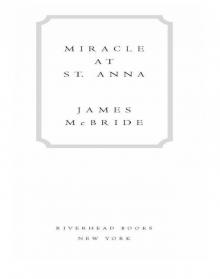 Miracle at St. Anna
Miracle at St. Anna The Good Lord Bird
The Good Lord Bird Song Yet Sung
Song Yet Sung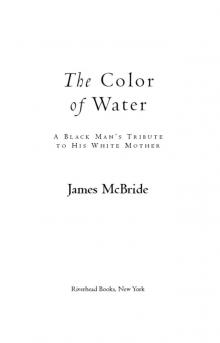 The Color of Water
The Color of Water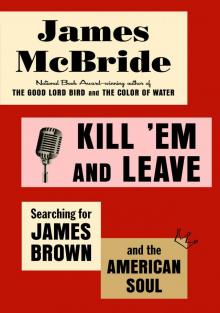 Kill 'Em and Leave
Kill 'Em and Leave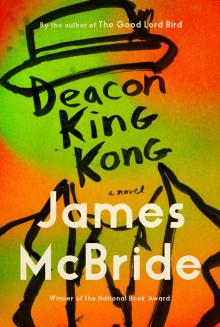 Deacon King Kong
Deacon King Kong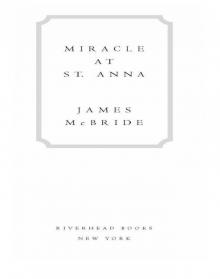 Miracle at St. Anna (Movie Tie-in)
Miracle at St. Anna (Movie Tie-in)